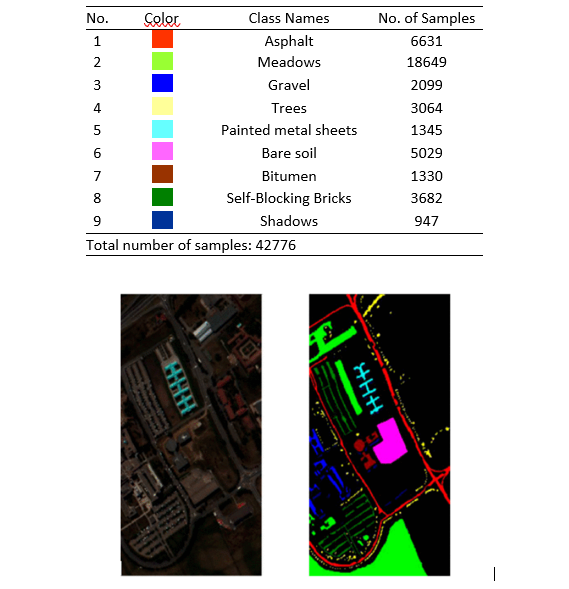Hyperspectral Image Classification
Using hybrid capsule networks
Researchers at Ulster University’s Intelligent Systems Research Centre (ISRC) are taking inspiration from biological neural organization to solve problems with complex hierarchal relationships. To do this the research makes use of cutting-edge computer hardware and novel deep learning algorithms to solve satellite image parcellation tasks (Table 1 & Figure 1) and conduct data analysis on speech recognition and movement coordination dynamics.
Among the challenges, limited labelled data, high dimensionality, image complexity, and similarity between classes make it difficult to perform classification using hyperspectral image (HSI) methods, often resulting in suboptimal classification performance. Recently, a capsule network (CapsNet) was introduced to recognize and preserve the hierarchy between different parts captured in an image by replacing the standard scalar- with vector-based operations. Mainly, a hybrid modification of a capsule network (HCapsNet) was proposed to address some of these limitations by proposing improvements to different areas in CapsNet research, such as network architecture and dynamic routing reconstruction [1].
Table 1: Labels and colour codes for images parcels detected in Figure 1.
Figure 1: CapsNet applied to automatic labelling of Natural composite images.
Apart from the current research, the ISRC group has successfully applied this technique to two different problems: imagined speech using EEG data [2] and image recognition for infants' movement (coordination dynamics) [3].
Using the NI-HPC’s GPUs and multicore resources has been critical to discover the best hyperparameter values, which is the most computational demanding step in deep learning modelling. In this case, the CapsNet model contains millions of trainable parameters (11.36M). Using the NI-HPC cluster led to a significant reduction in the learning time and an increase in the number of data analysis that could be carried out.
Contact for further information:
Mr Massoud Khodadadzadeh Email : m.khodadadzadeh@ulster.ac.uk ;
Twitter: @Masoudkhodadad
Project funded by Vice-Chancellor’s Research Scholarship (VCRS) at Ulster University. We are grateful for access to the Tier 2 High Performance Computing resources provided by the Northern Ireland High Performance Computing (NI-HPC) facility funded by the UK Engineering and Physical Sciences Research Council (EPSRC), Grant No. EP/T02217, the UKRI Turing AI Fellowship 2021-2025 funded by the EPSRC (grant number EP/V025724/1).
Linked Publications:
[1] Khodadadzadeh, Massoud, et al. "A hybrid capsule network for hyperspectral image classification." IEEE Journal of Selected Topics in Applied Earth Observations and Remote Sensing 14 (2021): 11824-11839.
[2] M. Khodadadzadeh, D. Coyle, “Imagined Speech Classification from Electroencephalography with a Features-Guided Capsule Neural Network,” in: 15th Irish Human Computer Interaction (iHCI) Symposium, Belfast, UK, 1 pp, 2022.
[3] Pending publication: 2D Capsule Networks Detect Perceived Changes in Infant~Environment Relationship Reflected in 3D Infant Movement Dynamics
.

